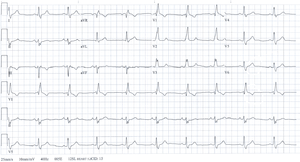Bifascicular block
| Bifascicular block | |
|---|---|
 | |
| Classification and external resources | |
| Specialty | cardiology |
| ICD-10 | I45.2 |
| ICD-9-CM | 426.53 |
Bifascicular block is a conduction abnormality in the heart where two of the three main fascicles of the His/Purkinje system are blocked.
Most commonly, it refers to a combination of right bundle branch block (RBBB) and either left anterior fascicular block (LAFB) or left posterior fascicular block (LPFB), with the former being more common.[1]
Some authors consider left bundle branch block (LBBB) to be a technical bifascicular block, since the block occurs above the bifurcation of the left anterior and left posterior fascicles of the left bundle branch.
Treatment
In those with bifascicular block and no symptoms, little with respect to treatment is needed. In those with syncope, a pacemaker is recommended.
References
- ↑ "Lesson VI - ECG Conduction Abnormalities". Archived from the original on 16 January 2009. Retrieved 2009-01-07.
External links
This article is issued from Wikipedia - version of the 9/9/2016. The text is available under the Creative Commons Attribution/Share Alike but additional terms may apply for the media files.